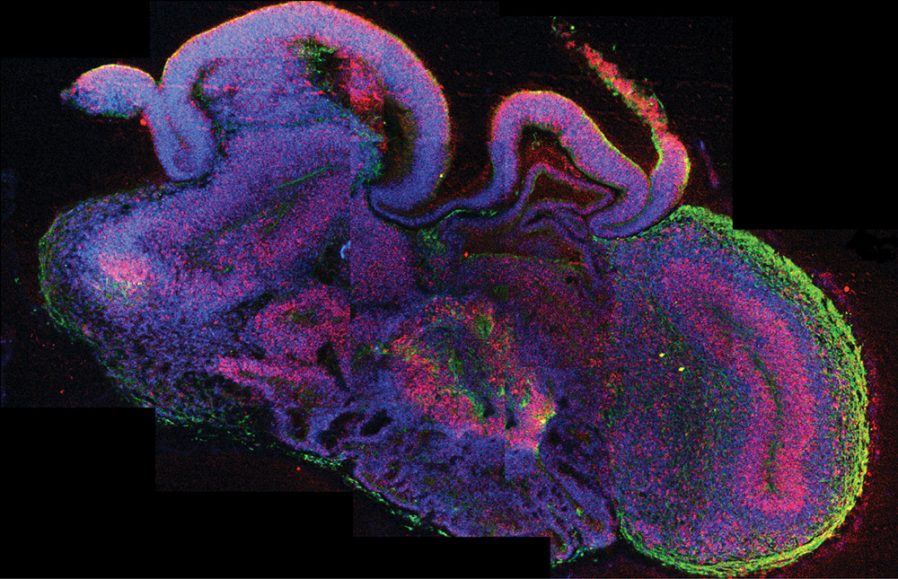Building an almost-brain
Cells in the lab weave themselves into tiny, brainlike structures

Not a squid. This lab-grown tissue has brainlike structures, including neurons (in green) and the stem cells that will make more neurons (here appearing red and purple).
Madeline A. Lancaster
Special cells can weave themselves together into blobs that, under a microscope, look a lot like the brain tissue in a developing fetus. You might think of these cellular masses as “brains-under-development.” Madeline Lancaster and Jürgen Knoblich offer a more technical name for them: “cerebral organoids.” Working at the Austrian Academy of Science in Vienna, these molecular biologists helped develop the almost-brain tissue.
The tiny blobs are not nearly as complex as a full-fledged human brain. They do represent a close approximation, however. These balls of tissue — each no bigger than a BB pellet — developed some of a brain’s structures and cells. As such, the balls point to a new way to study normal brain development and also brain defects. Researchers may also use the organoids to test the safety of new drugs without putting people at risk. Lancaster and Knoblich’s team (some of whom work in England and Scotland) reported its findings August 28 in the journal Nature.
“They’ve done something very remarkable,” Flora Vaccarino told Science News. She’s a neuroscientist at Yale University in New Haven, Conn., and did not work on the new study.
The European scientists used stem cells, which are a lot like students. Just as students haven’t yet developed into doctors, scientists and teachers, stem cells haven’t yet developed into the mature cells needed by the body. Stem cells play a key role in the development of an embryo. An embryo is an animal in its earliest stage of development in the womb. Embryonic stem cells will eventually mature into all of the specialized cells that make up our organs, including the brain. Scientists study these stem cells to better learn how the human body develops and how diseases might be treated.
People carry another type of stem cell, too. On their own, these stem cells can’t turn into any type of cell. They specialize into the type of cells where they’re found to help the body repair or maintain tissue. Scientists, however, can manipulate these stem cells to behave more like the embryonic stem cells that can develop into any type of tissue.
In the new experiment, researchers worked with embryonic stem cells and stem cells that had been taken from an adult and coaxed to behave like embryonic ones. The scientists bathed the living stem cells in a solution that encouraged them to grow. The cells responded by dividing to make more cells. Over time, these cells formed intact tissue. Once that tissue began to grow larger, the scientists injected these globs of cells into a droplet of gel. That gel provided structure for the emerging organoid. Finally, to make sure the new tissue didn’t starve, the scientists put the cells in a spinning flask full of nutrients. (The spinning helped deliver food to every part of the tissue.)
After two months, the tissue had outgrown the gel droplet and now measured about 4 millimeters (0.16 inch) across. The scientists have already grown hundreds of these mini brainlike bits. And at this stage of development, the tissue’s stem cells have begun to mature into specialized cells called neurons. These are the primary cells that make up the brain. These neurons have even begun organizing into brain structures. One was the hippocampus, a center of memory and emotion. Another was the cerebral cortex, the outer layer of the brain. Experiments showed that some neurons were sending out signals, a sign of activity.
The European team is now using their organoids to investigate how some diseases start.
“There is enormous potential there,” Ed Lein told Science News. Lein is a neuroscientist at the Allen Institute for Brain Science in Seattle, Wash. He did not work on the new study. The biggest surprise, Lein says, was learning that the stem cells hold the blueprints for building mature organs: “These cells carry enough information to generate a brain.”
Power Words
biology The study of living things.
embryo A vertebrate, or animal with a backbone, in its early stages of development.
fetus The term for a mammal during its later stages of development in the womb. For humans, this term is usually applied after the eighth week of development.
molecular biology The branch of biology that deals with the structure and function of molecules essential to life.
neuroscience Science that deals with the structure or function of the brain and other parts of the nervous system.
organoid A structure that resembles an organ. An organ is a collection of cells and tissues working together to perform some function.
stem cell A “blank slate” cell that can give rise to other types of cells in the body. Stem cells play an important role in tissue regeneration and repair.
tissue Any of the distinct types of material, comprised of cells, which make up animals, plants or fungi.







